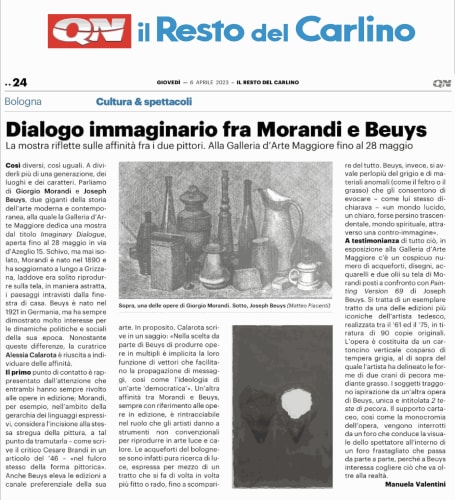So different, yet so alike. Divided by more than a generation, by places and personalities. We’re talking about Giorgio Morandi and Joseph Beuys, two giants in the history of modern and contemporary art, to whom the Galleria d'Arte Maggiore dedicates an exhibition titled Imaginary Dialogue, open until May 28 at Via d'Azeglio 15. Reserved but never isolated, Morandi was born in 1890 and spent long periods in Grizzana, where he would abstractly reproduce on canvas the landscapes glimpsed from his home window. Joseph Beuys, on the other hand, was born in 1921 in Germany but always showed a strong interest in the political and social dynamics of his time.
Despite these differences, curator Alessia Calarota has identified affinities between the two figures. The first point of contact is the importance both artists placed on editioned works. Morandi, for instance, within the hierarchy of expressive languages, regarded etching on par with painting—so much so that, as the critic Cesare Brandi wrote in a 1946 article, he turned it "into the very fulcrum of pictorial form". Likewise, Beuys elevated editions as a preferred channel for his art, stating his interest in them as a tool for spreading ideas. On this, Calarota writes in an essay: "Beuys’ choice to produce works in multiples implies their function as vehicles facilitating the spread of messages, in line with the ideology of a “democratic” art—accessible and available to as many people as possible."
Another similarity between Morandi and Beuys, again in relation to editioned works, lies in the fundamental role both attribute to light. The Bolognese painter’s etchings are, in fact, pure explorations of light, expressed through a line that becomes denser or sparser until it disappears completely. Beuys, instead, used mostly gray tones and unusual materials (like felt or fat, for example), which allowed him to evoke—as he himself stated in a contemporary writing— "a lucid world, a bright, perhaps even transcendental spiritual world […] through a counter-image."
To illustrate this, the Galleria d’Arte Maggiore is exhibiting a substantial number of etchings, drawings, watercolors, and two oil paintings on canvas by Giorgio Morandi, displayed alongside Painting Version 69 by Joseph Beuys. This work is one of the most iconic editions by the German artist, created between 1961 and 1975 in a run of 90 original copies. It consists of a vertical cardboard covered in gray tempera, upon which the artist outlined the forms of two sheep skulls using fat. The subjects are inspired by another unique Beuys work, titled precisely 2 Sheep Heads. The paper support and the monochrome composition are interrupted by a hole that leads the viewer’s gaze into a white cavity, because Beuys was interested in capturing what lies beyond reality.


